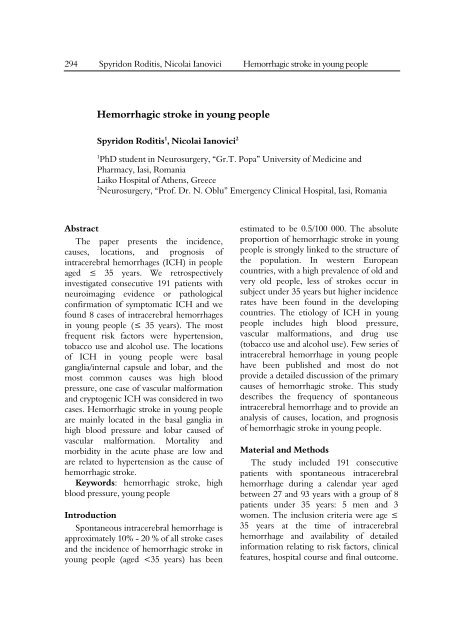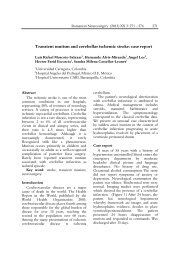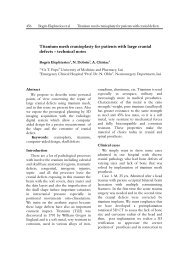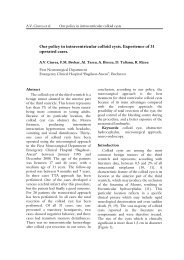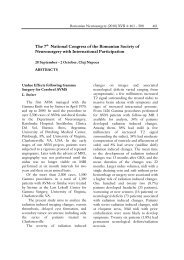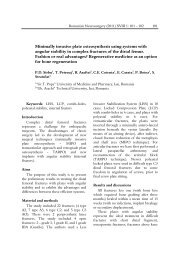Hemorrhagic stroke in young people - Romanian Neurosurgery
Hemorrhagic stroke in young people - Romanian Neurosurgery
Hemorrhagic stroke in young people - Romanian Neurosurgery
You also want an ePaper? Increase the reach of your titles
YUMPU automatically turns print PDFs into web optimized ePapers that Google loves.
294 Spyridon Roditis, Nicolai Ianovici <strong>Hemorrhagic</strong> <strong>stroke</strong> <strong>in</strong> <strong>young</strong> <strong>people</strong><br />
<strong>Hemorrhagic</strong> <strong>stroke</strong> <strong>in</strong> <strong>young</strong> <strong>people</strong><br />
Spyridon Roditis 1 , Nicolai Ianovici 2<br />
1 PhD student <strong>in</strong> <strong>Neurosurgery</strong>, “Gr.T. Popa” University of Medic<strong>in</strong>e and<br />
Pharmacy, Iasi, Romania<br />
Laiko Hospital of Athens, Greece<br />
2 <strong>Neurosurgery</strong>, “Prof. Dr. N. Oblu” Emergency Cl<strong>in</strong>ical Hospital, Iasi, Romania<br />
Abstract<br />
The paper presents the <strong>in</strong>cidence,<br />
causes, locations, and prognosis of<br />
<strong>in</strong>tracerebral hemorrhages (ICH) <strong>in</strong> <strong>people</strong><br />
aged ≤ 35 years. We retrospectively<br />
<strong>in</strong>vestigated consecutive 191 patients with<br />
neuroimag<strong>in</strong>g evidence or pathological<br />
confirmation of symptomatic ICH and we<br />
found 8 cases of <strong>in</strong>tracerebral hemorrhages<br />
<strong>in</strong> <strong>young</strong> <strong>people</strong> (≤ 35 years). The most<br />
frequent risk factors were hypertension,<br />
tobacco use and alcohol use. The locations<br />
of ICH <strong>in</strong> <strong>young</strong> <strong>people</strong> were basal<br />
ganglia/<strong>in</strong>ternal capsule and lobar, and the<br />
most common causes was high blood<br />
pressure, one case of vascular malformation<br />
and cryptogenic ICH was considered <strong>in</strong> two<br />
cases. <strong>Hemorrhagic</strong> <strong>stroke</strong> <strong>in</strong> <strong>young</strong> <strong>people</strong><br />
are ma<strong>in</strong>ly located <strong>in</strong> the basal ganglia <strong>in</strong><br />
high blood pressure and lobar caused of<br />
vascular malformation. Mortality and<br />
morbidity <strong>in</strong> the acute phase are low and<br />
are related to hypertension as the cause of<br />
hemorrhagic <strong>stroke</strong>.<br />
Keywords: hemorrhagic <strong>stroke</strong>, high<br />
blood pressure, <strong>young</strong> <strong>people</strong><br />
Introduction<br />
Spontaneous <strong>in</strong>tracerebral hemorrhage is<br />
approximately 10% - 20 % of all <strong>stroke</strong> cases<br />
and the <strong>in</strong>cidence of hemorrhagic <strong>stroke</strong> <strong>in</strong><br />
<strong>young</strong> <strong>people</strong> (aged
<strong>Romanian</strong> <strong>Neurosurgery</strong> (2011) XVIII 3: 294 – 299 295<br />
We retrospectively analyzed the cl<strong>in</strong>ical and<br />
radiological data from those patients with<br />
neuroimag<strong>in</strong>g or neuropathological<br />
evidence of spontaneous <strong>in</strong>tracerebral<br />
hemorrhage. The patients with primary<br />
subarachnoid and traumatic hemorrhages<br />
and those with a previously diagnosed<br />
vascular malformation, aneurysm or bra<strong>in</strong><br />
tumor were excluded.<br />
We analyzed <strong>in</strong> each patient the risk<br />
factors: high blood pressure, use of<br />
antihypertensive drugs, previous medical<br />
diagnosis of arterial hypertension, tobacco<br />
use, alcohol use and oral contraceptive use,<br />
regular use dur<strong>in</strong>g the last year.<br />
Classification of each hematoma location<br />
was based on the location of the center of<br />
the hematoma as lobar (frontal, parietal,<br />
temporal, occipital), thalamic, basal<br />
ganglia/<strong>in</strong>ternal capsule established by CT<br />
or MRI. (Figure 1, 2 and 3).<br />
The etiology of hemorrhagic <strong>stroke</strong> was<br />
def<strong>in</strong>ed <strong>in</strong> accordance with the follow<strong>in</strong>g<br />
criteria:<br />
- arterial hypertension and<br />
documentation of high blood pressure, as<br />
well as exclusion of other potential cause of<br />
ICH;<br />
- arteriovenous malformation confirmed<br />
by MRI or bra<strong>in</strong> angiography;<br />
- drug use and tobacco use or alcohol<br />
use and the hemorrhagic <strong>stroke</strong> <strong>in</strong> close<br />
temporal relation to use of drugs and<br />
exclusion of other potential causes;<br />
- hematologic disorders, and<br />
- cryptogenic, patients without risk<br />
factors or predispos<strong>in</strong>g conditions <strong>in</strong> whom<br />
structural abnormalities were not found on<br />
MRI or cerebral angiography to expla<strong>in</strong><br />
hemorrhagic <strong>stroke</strong> and with follow-up<br />
dur<strong>in</strong>g a year.<br />
TABLE 1<br />
Distribution of hemorrhagic <strong>stroke</strong> by<br />
age and sex<br />
Age Man Women<br />
27 - 35 years 5 3<br />
36 - 93 years 108 75<br />
Figure 1 CT image of frontal <strong>in</strong>tracerebral lobar<br />
hematoma<br />
Figure 2 CT image of basal ganglia hematoma
296 Spyridon Roditis, Nicolai Ianovici <strong>Hemorrhagic</strong> <strong>stroke</strong> <strong>in</strong> <strong>young</strong> <strong>people</strong><br />
Results<br />
The most common locations of<br />
hemorrhagic <strong>stroke</strong> were basal<br />
ganglia/<strong>in</strong>ternal capsule <strong>in</strong> 4 patients and<br />
lobar <strong>in</strong> 4 patients . The most common<br />
causes of ICH were hypertension <strong>in</strong> five<br />
patients, the rupture of an arteriovenous<br />
malformation <strong>in</strong> one patient and <strong>in</strong> two<br />
patients we could not demonstrate the<br />
cause of <strong>in</strong>tracerebral hemorrhage. All 5<br />
patients from our series with hemorrhagic<br />
<strong>stroke</strong> related to hypertension had<br />
persistent <strong>in</strong>crease of blood pressure.<br />
Surgery was successful <strong>in</strong> three patients<br />
with lobar <strong>in</strong>tracerebral hemorrhage : the<br />
case of the arteriovenous malformation and<br />
<strong>in</strong> two patients with cryptogenic<br />
hemorrhagic <strong>stroke</strong> and they were<br />
discharged home with no neurological<br />
deficits.<br />
Discussion<br />
Spontaneous hemorrhagic <strong>stroke</strong> <strong>in</strong><br />
<strong>young</strong> <strong>people</strong> ( aged
<strong>Romanian</strong> <strong>Neurosurgery</strong> (2011) XVIII 3: 294 – 299 297<br />
patients (24.7%). Also they found that<br />
<strong>young</strong> adults with nontraumatic<br />
<strong>in</strong>tracerebral are a heterogeneous group and<br />
hypertension accounts for about one-third<br />
of <strong>in</strong>tracerebral hemorrhage and it is an<br />
important preventable cause of<br />
hemorrhagic <strong>stroke</strong> <strong>in</strong> <strong>young</strong> adults .<br />
We evaluated 191 patients diagnosed<br />
with hemorrhagic <strong>stroke</strong> and <strong>young</strong> adults<br />
with nontraumatic <strong>in</strong>tracerebral<br />
hemorrhage were only 8 cases and the ma<strong>in</strong><br />
cause of hemorrhagic <strong>stroke</strong> <strong>in</strong> <strong>young</strong><br />
<strong>people</strong> was high blood pressure (for 5<br />
patients). Therefore arterial hypertension is<br />
an important preventable cause of<br />
hemorrhagic <strong>stroke</strong> <strong>in</strong> <strong>young</strong> adults.<br />
But <strong>in</strong> other series with large number of<br />
patients hypertension was responsible for a<br />
low percentage of <strong>in</strong>tracerebral hemorrhage<br />
and compared with other causes, this<br />
produced the worst outcome and resulted<br />
<strong>in</strong> high morbidity, mortality, and<br />
recurrence. Hypertension as a cause of<br />
<strong>in</strong>tracerebral hemorrhage was most<br />
common <strong>in</strong> <strong>in</strong>dividuals aged >31 years and<br />
the <strong>in</strong>tracerebral hemorrhage was often<br />
located <strong>in</strong> the basal ganglia.<br />
We found only a case of <strong>in</strong>tracerebral<br />
hemorrhage caused of the rupture of an<br />
arteriovenous malformation, but <strong>in</strong> other<br />
series the most common cause of<br />
<strong>in</strong>tracerebral hemorrhage was rupture of<br />
vascular malformations, <strong>in</strong>clud<strong>in</strong>g both<br />
arteriovenous malformation and cavernous<br />
angioma. The most common location of<br />
<strong>in</strong>tracerebral hemorrhage result<strong>in</strong>g from<br />
arteriovenous malformations was lobar.<br />
Cavernous angioma was most commonly<br />
located supratentorially but was the most<br />
common cause of <strong>in</strong>tracerebral hemorrhage<br />
located <strong>in</strong> the bra<strong>in</strong> stem.<br />
Cryptogenic <strong>in</strong>tracerebral hemorrhage<br />
was considered <strong>in</strong> two patients, compared<br />
with other studies that show cryptogenic<br />
<strong>in</strong>tracerebral hemorrhage <strong>in</strong> 15% of their<br />
patients, but the number of our cases is<br />
small.<br />
Risk factors for <strong>in</strong>tracerebral<br />
hemorrhage are known: age and race;<br />
hypertension, cerebral amyloid angiopathy,<br />
arteriovenous malformations, alcohol use<br />
and tobacco use.<br />
Age is the greatest risk factor for<br />
<strong>in</strong>tracerebral hemorrhage. Incidence rates<br />
<strong>in</strong>crease dramatically among persons older<br />
than 60 years. Hypertension is the most<br />
important and prevalent modifiable risk<br />
factor for ICH. Untreated hypertension is a<br />
greater risk factor than treated<br />
hypertension, and hypertensive patients<br />
who discont<strong>in</strong>ue their medications have<br />
greater risk than those who cont<strong>in</strong>ue them<br />
Cerebral amyloid angiopathy is now<br />
considered an important cause of lobar<br />
hemorrhage <strong>in</strong> the elderly.<br />
Aneurysms and vascular malformations<br />
are particularly important as a cause of<br />
<strong>in</strong>tracerebral hemorrhage among <strong>young</strong><br />
<strong>people</strong>, although <strong>in</strong> our series the rupture<br />
of an arteriovenous malformation was<br />
found only <strong>in</strong> one patient. Antiplatelet<br />
drugs probably <strong>in</strong>crease the risk of<br />
<strong>in</strong>tracerebral hemorrhage by a small<br />
amount. The absolute risk of <strong>in</strong>tracranial<br />
hemorrhage among elderly persons tak<strong>in</strong>g<br />
aspir<strong>in</strong> has been estimated at 0.2–0.3%<br />
annually (vs. 0.15% <strong>in</strong> similar persons not<br />
tak<strong>in</strong>g antiplatelets or anticoagulants).<br />
Numerous studies have identified a<br />
relationship between alcohol use and the<br />
risk of hemorrhagic <strong>stroke</strong> and also several<br />
studies suggest that current smok<strong>in</strong>g<br />
<strong>in</strong>creases the risk of <strong>in</strong>tracerebral<br />
hemorrhage .<br />
Spontaneous <strong>in</strong>tracerebral hemorrhage<br />
causes 10–15% of first ever <strong>stroke</strong>s and is
298 Spyridon Roditis, Nicolai Ianovici <strong>Hemorrhagic</strong> <strong>stroke</strong> <strong>in</strong> <strong>young</strong> <strong>people</strong><br />
associated with the highest mortality of all<br />
cerebrovascular events. The <strong>in</strong>itial<br />
diagnostic question <strong>in</strong> a patient with acute<br />
onset of focal neurological deficits is<br />
whether or not the deficits are caused by<br />
<strong>in</strong>tracerebral hemorrhage . The answer is of<br />
utmost importance <strong>in</strong> determ<strong>in</strong><strong>in</strong>g the<br />
direction of treatment. Non-contrast CT is<br />
the first-l<strong>in</strong>e imag<strong>in</strong>g modality <strong>in</strong> this<br />
sett<strong>in</strong>g. Computerized tomography scans<br />
are rapid, readily available, and relatively<br />
<strong>in</strong>expensive. Most importantly they have<br />
exquisite sensitivity and specificity,<br />
approach<strong>in</strong>g 100%, <strong>in</strong> the detection of acute<br />
blood.<br />
Because hypertension is the most<br />
common cause of spontaneous <strong>in</strong>tracerebral<br />
hemorrhage, its treatment <strong>in</strong> this sett<strong>in</strong>g is<br />
of considerable importance.<br />
Intracerebral hematoma growth may be<br />
accelerated by hypertension <strong>in</strong> the sett<strong>in</strong>g of<br />
acute <strong>in</strong>tracerebral hemorrhage. The<br />
occurrence of <strong>in</strong>tracerebral hemorrhage is<br />
strongly related to premorbid blood<br />
pressure; however, the relationship between<br />
the growth of hematoma and uncontrolled<br />
blood pressure rema<strong>in</strong>s to be clarified.<br />
Jauch et al demonstrated that there was<br />
no def<strong>in</strong>itive correlation between<br />
hemodynamic parameters,such as blood<br />
pressure and hematoma growth. The recent<br />
studies emphasize aggressive blood pressure<br />
control for a systolic blood pressure >200<br />
mmHg or mean arterial blood pressure<br />
(MAP) >150 mmHg . For an systolic blood<br />
pressure >180 mmHg (or MAP >130<br />
mmHg), with a suspicion of elevated ICP,<br />
ICP monitor<strong>in</strong>g is recommended; on the<br />
other hand if ICP elevation is not a concern<br />
based on the patient’s neurological<br />
exam<strong>in</strong>ation, a goal of systolic blood<br />
pressure
<strong>Romanian</strong> <strong>Neurosurgery</strong> (2011) XVIII 3: 294 – 299 299<br />
hemorrhage, an aggressive blood pressure<br />
control for a systolic blood pressure >200<br />
mmHg is needed.<br />
The surgical treatment of <strong>in</strong>tracerebral<br />
hematoma consist of a conventional<br />
craniotomy and evacuation of the clot<br />
under direct vision, with or without the<br />
microscope; a stereotactic aspiration<br />
through a burr hole - aspiration of a dense<br />
clot can be facilitated either by <strong>in</strong>stillation<br />
of fibr<strong>in</strong>olytic agents or by fragment<strong>in</strong>g it<br />
by means of an ultrasonic device and<br />
endoscopic surgery.<br />
Correspondence:<br />
Dr Spyridon Roditis<br />
Laiko Hospital of Athens<br />
AG.Thoma 17, Τ.Κ. 11527, Athens, Greece<br />
sproditis@yahoo.com<br />
References<br />
1. Buis DR, Van Den Berg R, Lagerwaard FJ, Vandertop<br />
WP. Bra<strong>in</strong> arteriovenous malformations: from diagnosis<br />
to treatment. J Neurosurg Sci. 2011 Mar;55(1):39-56.<br />
2. Coutts SB, Matysiak-Scholze U, Kohlhase J, Innes<br />
AM. Intracerebral hemorrhage <strong>in</strong> a <strong>young</strong> man. CMAJ.<br />
2011 Jan 11;183(1):E61-4.<br />
3. Ellis C. Stroke <strong>in</strong> <strong>young</strong> adults. Disabil Health J.<br />
2010;3(3):222-4.<br />
4. Fuh JL, Liu HC, Wang SJ, Lo YK , Lee LS<br />
Nontraumatic hemorrhagic <strong>stroke</strong> <strong>in</strong> <strong>young</strong> adults <strong>in</strong><br />
Taiwan, Journal of Stroke and Cerebrovascular<br />
Diseases, 1994, Vol 4, 2 ; 101-105<br />
5. Gandolfo C, Conti M. Stroke <strong>in</strong> <strong>young</strong> adults:<br />
epidemiology. Neurol Sci. 2003 May;24 Suppl 1:S1-3.<br />
6. Hopf NJ, Füllbier L. M<strong>in</strong>imally <strong>in</strong>vasive<br />
neurosurgery for vascular lesions. Neurosurg Cl<strong>in</strong> N<br />
Am. 2010 Oct;21(4):673-89, vii. Review.<br />
7. Savadi-Oskouei D, Sadeghi-Bazargani H, Hashemilar<br />
M, DeAngelis T. Symptomatologic versus<br />
neuroimag<strong>in</strong>g predictors of <strong>in</strong>-hospital survival after<br />
<strong>in</strong>tracerebral haemorrhage. Pak J Biol Sci. 2010 May<br />
1;13(9):443-7.<br />
8. Ste<strong>in</strong> M, Luecke M, Preuss M, Boeker DK, Joedicke<br />
A, Oertel MF. Spontaneous <strong>in</strong>tracerebral hemorrhage<br />
with ventricular extension and the grad<strong>in</strong>g of<br />
obstructive hydrocephalus: the prediction of outcome<br />
of a special life-threaten<strong>in</strong>g entity. <strong>Neurosurgery</strong>. 2010<br />
Nov;67(5):1243-51<br />
9. Stemer A, Ouyang B, Lee VH, Prabhakaran S.<br />
Prevalence and risk factors for multiple simultaneous<br />
<strong>in</strong>tracerebral hemorrhages. Cerebrovasc Dis. 2010<br />
Aug;30(3):302-7<br />
10.Tang SC, Jeng JS. Management of <strong>stroke</strong> <strong>in</strong><br />
pregnancy and the puerperium. Expert Rev Neurother.<br />
2010;10(2):205-15.<br />
11.Truelsen T, Piechowski-Jóźwiak B, Bonita R,<br />
Mathers C, Bogousslavsky J, Boysen G. Stroke<br />
<strong>in</strong>cidence and prevalence <strong>in</strong> Europe: a review of<br />
available data. Eur J Neurol. 2006;13(6):581-98.<br />
12.Virmani T, Agarwal A, Klawiter EC. Cl<strong>in</strong>ical<br />
reason<strong>in</strong>g: A <strong>young</strong> adult presents with focal weakness<br />
and hemorrhagic bra<strong>in</strong> lesions. Neurology. 2011 May<br />
31;76(22)<br />
13.Yu JL, Yang S, Luo Q, Wang HL, Wang B, Qu YY,<br />
Xu K. Endovascular treatment of <strong>in</strong>tracranial ruptured<br />
aneurysms associated with arteriovenous<br />
malformations: a cl<strong>in</strong>ical analysis of 14 hemorrhagic<br />
cases. Interv Neuroradiol. 2011 Mar;17(1):78-86.<br />
14.Wong GK, Siu DY, Abrigo JM, Poon WS, Tsang FC,<br />
Zhu XL, Yu SC, Ahuja AT. Computed tomographic<br />
angiography and venography for <strong>young</strong> or<br />
nonhypertensive patients with acute spontaneous<br />
<strong>in</strong>tracerebral hemorrhage. Stroke. 2011 Jan;42(1):211-3.


